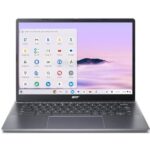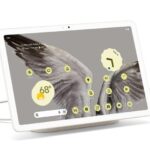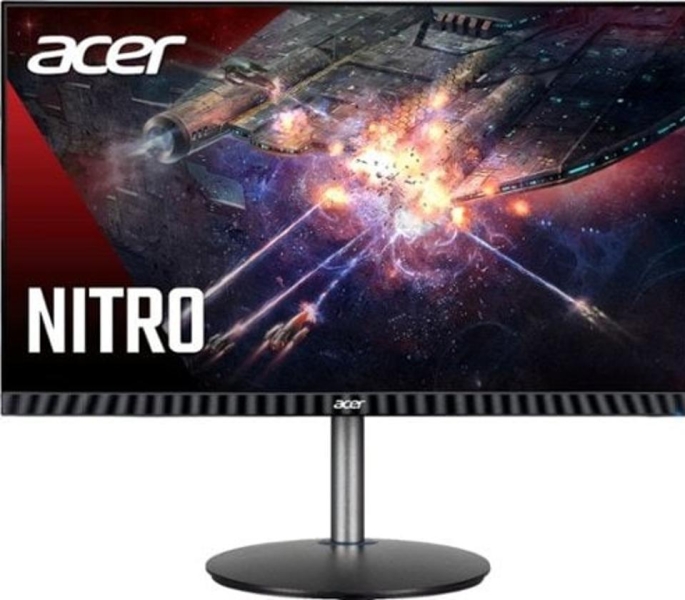
Acer Nitro XF243Y
Size: 24 inches | Type: IPS | Resolution: 1,920 x 1,080 | Refresh rate: 165Hz | Response time: 2ms | Curvature: None
Best for: Highly responsive gameplay at 1,080p on a smaller screen.
Pros:
- Very affordable
- Fast refresh rate and response time
- Efficient screen size for fast gaming
Cons:
- Lacks detail of 4K
- Limited screen space for productivity
The Acer Nitro XF243Y is a capable gaming monitor with a high refresh rate and a fast response time that makes it feel impressively fluid and responsive for such a budget display. Its 1,080p screen lacks the crisp detail of 4K, but the difference hits less on this 24-inch monitor than it would on a larger one. This monitor’s comparatively compact size also makes it easier to carry around if you want to take it to a LAN party. The stand has ergonomic adjustments, so you can find the right position for your eyes. You can also rotate the screen around 360 degrees, which makes it really easy to access the ports or to share the screen with a friend or colleague.
The fast refresh rate is great for competitive gaming, especially when combined with the 2ms input lag. It also supports AMD’s FreeSync Premium, to mitigate screen tearing. The brightness level on this monitor is less than on more expensive models, so it’s not the best monitor for gaming in brightly lit rooms.
Best Portable Monitor
Fast, Lightweight, Great Battery Life

SideTrak Solo 4K
Size: 15.6 inches | Type: TFT |Resolution: 3,840 x 2,160 | Refresh rate: 60Hz | Response time: 25ms | Curvature: N/A
Best for: Creatives and artists who crave portable, high-res detail.
Pros:
- Superior 4K resolution
- Multiple connectivity ports and options
- Built-in stereo speakers
Cons:
- Expensive
- Not good for gaming
The SideTrak Solo 4K is a free-standing portable monitor. This monitor targets productivity needs. It has a 60Hz refresh rate and a sluggish 25ms response time, which means you can expect to see ghosting while playing games (you can get much better portable displays for gaming, including the Asus below). However, for creative individuals and businesses looking to keep a high-fidelity touchscreen display with you at all times, it’s hard to beat. It connects to your computer using a single cable and also has a built-in blue light filter to help reduce eyestrain.
With dynamic contrast ratio (DCR), you can switch seamlessly from business to watching movies—and see everything with rich, vivid colors and detailed clarity. All of this comes in a package that weighs only 2.9 pounds—which is about the same as some lightweight laptops.
Honorable Mention: A Fast Portable Gaming Monitor
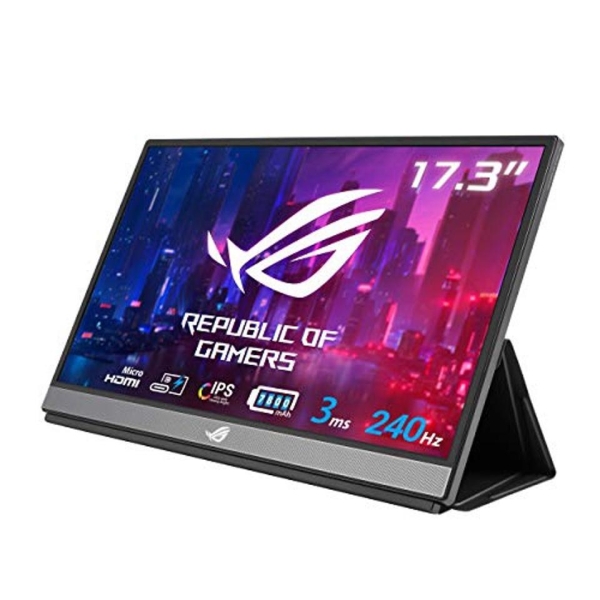
Asus ROG Strix XG17AHPE
Size: 17.3 inches | Type: IPS |Resolution: 1,920 x 1,080 | Refresh rate: 240Hz | Response time: 3ms | Curvature: N/A
Best for: Gaming on a large, portable display while minimizing screen tear.
Pros:
- High refresh rate for fluid, responsive gaming
- Enough battery life for extended gaming sessions
- Roomy display
Cons:
- Expensive
The Asus ROG XG17AHPE monitor provides a 17.3-inch screen that’s perfect for gaming on the go. Just plug it into a video source—a phone, laptop, game console, camera, tablet or more—via USB-C or micro-HDMI and enjoy a big-screen gaming experience. It has 240Hz refresh rate support, as well as adaptive-sync for reducing motion-blur and screen tear. The 3ms response is just behind the fastest gaming monitors, but it is far better than most monitors.
This monitor has excellent colors, with wide color gamut support of 100% sRGB. This model is one of the rare portable monitors that includes its own battery. The battery lasts around three hours during mixed use. The entire package weighs 2.3 pounds, impressively light for such a large screen and battery.
Best Ultrawide Monitor
Huge, Fast and Gorgeous
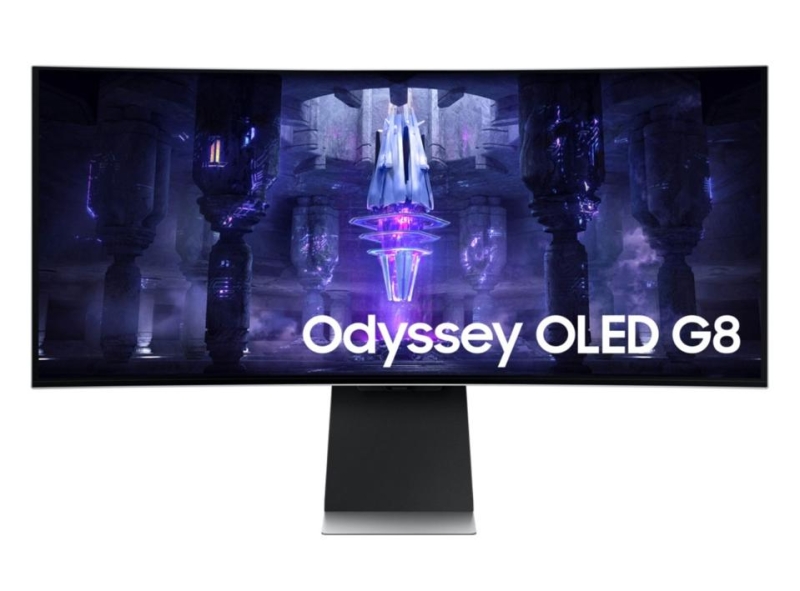
Samsung OLED G85SB
Size: 34 inches | Type: QD-OLED | Resolution: 3,440 x 1,440 | Refresh rate: 175Hz | Response time: 0.03ms | Curvature: 1800R
Best for: Gaming, work, watching movies—just about anything.
Pros:
- Incredibly thin
- Gorgeous OLED picture quality
- Fast and responsive for gaming
Cons:
- Expensive, even with recent price cuts
- Ports all use mini connections
The Samsung G8 OLED is a super wide, super detailed display that’s great for work, play, movies, and anything else you can throw at it. It offers incredible contrast, super bright and vibrant colors and a rich picture that you just don’t find on most LCD monitors—the QD-OLED panel really makes a difference. The color support is incredibly broad and deep, with 99% of the professional DVI-P3 gamut covered, and 94% of AdobeRGB. Reviewers report a color accuracy that’s below 1.0—good enough for professional work—and excellent HDR support. Typical brightness is 250 nits, but some reviewers claim that hotspot brightness can get close to 500, so HDR movies really pop off the screen.
All OLEDs are great for gaming, but this monitor is especially impressive. It’s huge, for starters, but not as wide as the G9, so it doesn’t leave black bars either side of your game. But it still gives you lots of screen space and a horizontal field of view. The high refresh rate makes games feel responsive and look smooth, and with a response time that’s sub 0.1ms, there’s no ghosting to be found. Its selection of ports is a little aggravating, as they’re all mini versions, but there’s USB-C with power delivery for charging devices if you want. There’s even Samsung’s Tizen OS built in so you can natively watch Netflix and use other apps—even Samsung’s Gaming Hub is available for streaming.
How We Chose The Monitors
We compiled this list of the best monitors based on firsthand testing, product demonstrations, insights from colleagues and other experts and thorough research.
- The Forbes Vetted team has hands-on tested many of the best monitors on the market, which augments are already extensive knowledge on the topic.
- In addition to learning about them directly from the manufacturers, Isaacs tested many of them herself in person at recent hands-on events.
- We consulted other colleagues and industry experts and read through user reviews to get a full picture of what constitutes the best monitors in 2024, for users of all types.
- We evaluated each product based on features like resolution, refresh rate, panel technology, backlighting, response time and more.
What To Consider When Buying A Monitor
Buying the right monitor for you means taking stock of your budget, your available space and considering what it is you want to do with the display. Do you want to play games or do some work on the new screen? Do you have a powerful graphics card for gaming, or do you need a lightweight display to take with you on the road?
A big monitor—especially a big curved monitor—can make games more immersive or give you more screen space to work with when working. They also take up a lot more room and often demand a higher resolution to enjoy the same level of detail and clarity.
Make sure you have the physical space for whatever display you consider. Also, don’t buy a bigger screen only to find you don’t have the room to sit far enough back from it to make the most of it. You don’t want to be sitting two feet from a 48-inch screen, having to turn your head to look at the sides.
Traditional monitors are 16:9 for resolutions like 1,920 x 1,080 (1080p) and 3,840 x 2,160 (4K). There are some laptops which have 16:10 displays to add vertical screen space for browsing long websites or working on long documents.
There are also 21:9 ultrawide displays, which can give you a movie-watching experience without black bars, some added immersion in compatible games and more horizontal space to fit your work windows on. The biggest ultrawides even come in 32:9, though those are better suited to multiple windows than a single application or game, as few support such aspect ratios.
Typically, monitors come in 4K or 2K, but baseline models still rely on 1,920 x 1,080 resolution. While the latter delivers full high-definition images, in today’s world the advantage goes to a 2K or 4K monitor, which can show a sharper, more detailed image—especially on a larger screen.
A 4K is also a must-have if you want to watch UHD movies and TV shows, but it also demands icon scaling in Windows to make text and images legible. While 4K monitors are ubiquitous, they are usually more expensive than more modest resolutions. It also can mean sacrificing other features like higher refresh rates and better color accuracy, unless you buy the most expensive options.
If you play fast-paced games—particularly competitive fast-paced games like esports—you almost require a high-refresh-rate monitor. They make the action smoother, but if you can hit high enough frame rates, that can give you a competitive advantage too. By getting the image to you faster and more frequently, your high-refresh-rate monitor can give you a few milliseconds advantage over the competition, and it reduces input lag.
When choosing a display, faster is typically better, although there are diminishing returns the higher you go. A 120Hz monitor is a major upgrade over 60Hz, and 240Hz is a reasonable jump again. For nongamers, high refresh rates aren’t as important, though they can make watching sports and fast action clearer, and it makes mouse pointer movement smoother and easier to track.

